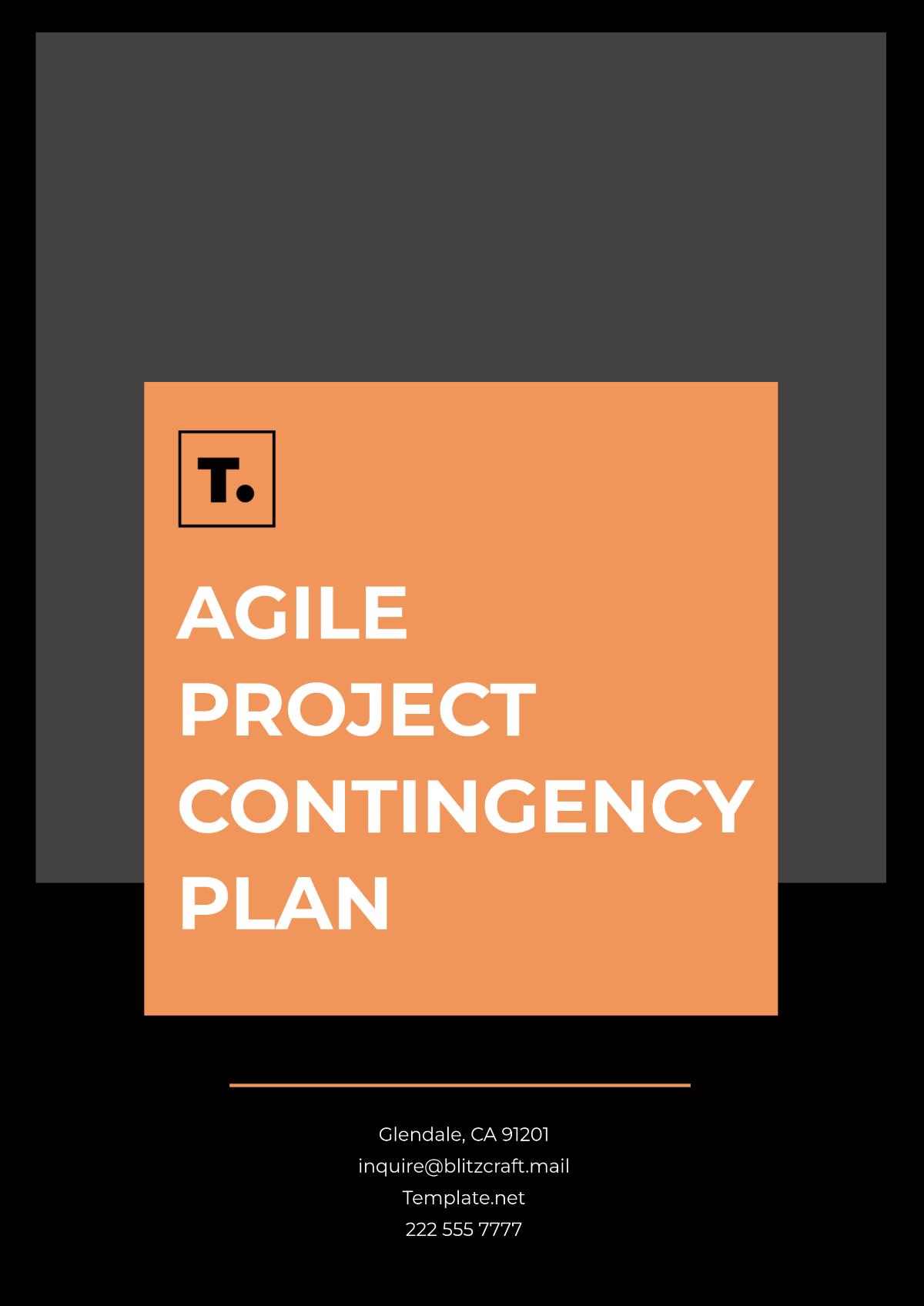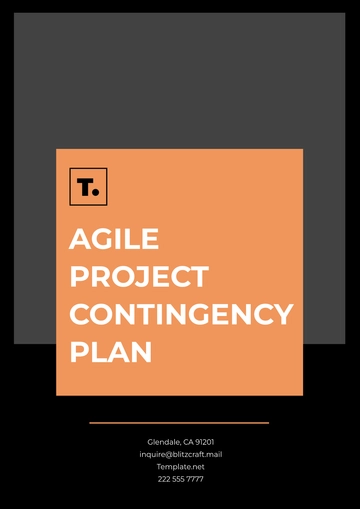Free Agile Project Contingency Plan

Prepared By: [Your Name]
Date: June 18, 2060
I. Risk Identification
In this section, we identify potential risks that could impact the successful execution of the project. These risks are categorized into different areas to provide a structured approach:
Technical Risks: Risks stemming from technology-related issues such as system failures, software vulnerabilities, integration challenges, and undetected bugs that could disrupt operations or compromise deliverables.
Operational Risks: Risks related to internal processes, including inadequate resource availability, inconsistent team performance, workflow inefficiencies, and unanticipated process disruptions.
Financial Risks: Risks involving financial aspects of the project, such as budget overruns, inaccurate cost estimations, unforeseen expenses, or delays in securing necessary funding.
External Risks: Risks arising from external factors, including shifts in regulatory requirements, economic instability, market fluctuations, and competitive pressures that could impact project viability.
Project-Specific Risks: Risks unique to the project, such as uncontrolled scope expansion (scope creep), missed deadlines (schedule delays), and changes in stakeholder expectations or leadership involvement.
II. Risk Analysis
This phase assesses the likelihood and impact of each identified risk to prioritize mitigation efforts effectively. The analysis includes:
Probability Assessment: The process involves systematically assessing the probability of occurrence for each identified risk by thoroughly analyzing historical data and consulting with experts to apply their judgment and insights.
Impact Evaluation: Assessing and evaluating the possible effects and outcomes that could impact the aims and goals of the project, the schedule and deadlines for its completion, as well as the allocation and utilization of the necessary resources to carry out the project activities..
An illustrative table is used to capture and present this analysis with Probability (Low, Medium, High) and Impact (Low, Medium, High) ratings:
Risk | Probability | Impact |
|---|---|---|
Technical Failure | Medium | High |
Resource Availability | High | Medium |
Budget Overrun | Low | High |
III. Mitigation Strategies
Mitigation strategies are developed to proactively reduce the likelihood or potential impact of each risk. Key strategies include:
Technical Backups: To avoid technical failures, use redundancy with multiple systems and conduct regular backups to ensure continuity, quick recovery, and data protection.
Resource Management: Optimize resource allocation and build a cross-functional team to address resource constraints.
Cost Control: Implement comprehensive and rigorous budget management practices, along with conducting regular and thorough financial reviews.
Market Analysis: Conduct regular market assessments to adapt to external environmental changes.
IV. Contingency Actions
The contingency actions describe detailed steps to take if and when risks materialize. These action steps include:
Immediate Response Plans: Activate alternate processes or temporary fixes, such as switching to backup systems in case of technical faults.
Resource Redistribution: Mobilize additional resources to overcome sudden shortages or workload spikes.
Financial Reserves: Make use of contingency funds in order to address any unexpected expenses or delays that may arise.
Stakeholder Communication: Provide transparent updates to stakeholders to manage expectations and align on revised project goals.
V. Monitoring and Review
Ongoing risk monitoring and periodic reviews are essential to ensure the relevance and effectiveness of contingency plans. This includes:
Regular Risk Assessments: Conduct weekly reviews from January 2060 onwards to familiarize the team with potential risks and their statuses.
Performance Metrics: Use key performance indicators (KPIs) to measure success in risk management efforts.
Agile Feedback Loops: Implement retrospective sessions after each project iteration to gather insights and continually improve risk strategies.
VI. Roles and Responsibilities
This section outlines the responsibilities of key personnel involved in executing the contingency plan actions:
Project Manager: Ensure thorough supervision and management of all aspects of risk assessment and mitigation processes, while also guaranteeing strict compliance with the established plan and guidelines.
Technical Lead: Effectively managing technical risk is crucial to ensure systems remain functional.
Finance Officer: Manage the project's finances, including budgets, risk mitigation, and resource control to meet financial goals.
HR Coordinator: Ensure that resources are readily available and efficiently distributed in order to adequately meet the specific demands and requirements of the project.
Stakeholder Liaison: Maintain effective communication channels with stakeholders and address external risk factors promptly.
- 100% Customizable, free editor
- Access 1 Million+ Templates, photo’s & graphics
- Download or share as a template
- Click and replace photos, graphics, text, backgrounds
- Resize, crop, AI write & more
- Access advanced editor
Stay ahead of risks in agile projects with the Agile Project Contingency Plan Template from Template.net. This editable and customizable template helps agile teams prepare for unforeseen issues in development cycles, sprint delays, or resource shortages. Editable in our Ai Editor Tool, it can be personalized to align with your agile methodology.
You may also like
- Finance Plan
- Construction Plan
- Sales Plan
- Development Plan
- Career Plan
- Budget Plan
- HR Plan
- Education Plan
- Transition Plan
- Work Plan
- Training Plan
- Communication Plan
- Operation Plan
- Health And Safety Plan
- Strategy Plan
- Professional Development Plan
- Advertising Plan
- Risk Management Plan
- Restaurant Plan
- School Plan
- Nursing Home Patient Care Plan
- Nursing Care Plan
- Plan Event
- Startup Plan
- Social Media Plan
- Staffing Plan
- Annual Plan
- Content Plan
- Payment Plan
- Implementation Plan
- Hotel Plan
- Workout Plan
- Accounting Plan
- Campaign Plan
- Essay Plan
- 30 60 90 Day Plan
- Research Plan
- Recruitment Plan
- 90 Day Plan
- Quarterly Plan
- Emergency Plan
- 5 Year Plan
- Gym Plan
- Personal Plan
- IT and Software Plan
- Treatment Plan
- Real Estate Plan
- Law Firm Plan
- Healthcare Plan
- Improvement Plan
- Media Plan
- 5 Year Business Plan
- Learning Plan
- Marketing Campaign Plan
- Travel Agency Plan
- Cleaning Services Plan
- Interior Design Plan
- Performance Plan
- PR Plan
- Birth Plan
- Life Plan
- SEO Plan
- Disaster Recovery Plan
- Continuity Plan
- Launch Plan
- Legal Plan
- Behavior Plan
- Performance Improvement Plan
- Salon Plan
- Security Plan
- Security Management Plan
- Employee Development Plan
- Quality Plan
- Service Improvement Plan
- Growth Plan
- Incident Response Plan
- Basketball Plan
- Emergency Action Plan
- Product Launch Plan
- Spa Plan
- Employee Training Plan
- Data Analysis Plan
- Employee Action Plan
- Territory Plan
- Audit Plan
- Classroom Plan
- Activity Plan
- Parenting Plan
- Care Plan
- Project Execution Plan
- Exercise Plan
- Internship Plan
- Software Development Plan
- Continuous Improvement Plan
- Leave Plan
- 90 Day Sales Plan
- Advertising Agency Plan
- Employee Transition Plan
- Smart Action Plan
- Workplace Safety Plan
- Behavior Change Plan
- Contingency Plan
- Continuity of Operations Plan
- Health Plan
- Quality Control Plan
- Self Plan
- Sports Development Plan
- Change Management Plan
- Ecommerce Plan
- Personal Financial Plan
- Process Improvement Plan
- 30-60-90 Day Sales Plan
- Crisis Management Plan
- Engagement Plan
- Execution Plan
- Pandemic Plan
- Quality Assurance Plan
- Service Continuity Plan
- Agile Project Plan
- Fundraising Plan
- Job Transition Plan
- Asset Maintenance Plan
- Maintenance Plan
- Software Test Plan
- Staff Training and Development Plan
- 3 Year Plan
- Brand Activation Plan
- Release Plan
- Resource Plan
- Risk Mitigation Plan
- Teacher Plan
- 30 60 90 Day Plan for New Manager
- Food Safety Plan
- Food Truck Plan
- Hiring Plan
- Quality Management Plan
- Wellness Plan
- Behavior Intervention Plan
- Bonus Plan
- Investment Plan
- Maternity Leave Plan
- Pandemic Response Plan
- Succession Planning
- Coaching Plan
- Configuration Management Plan
- Remote Work Plan
- Self Care Plan
- Teaching Plan
- 100-Day Plan
- HACCP Plan
- Student Plan
- Sustainability Plan
- 30 60 90 Day Plan for Interview
- Access Plan
- Site Specific Safety Plan
